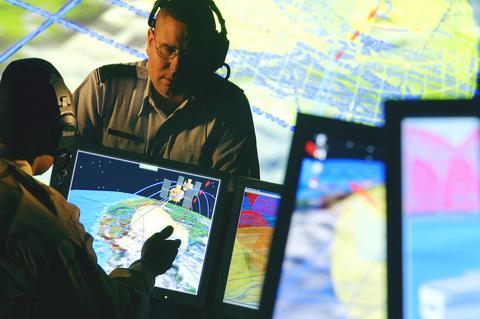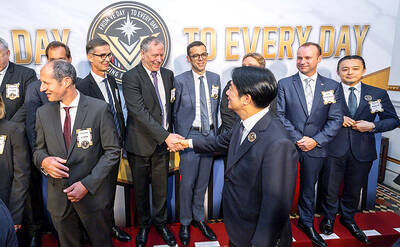Lockheed Martin doesn't run the US. But it does help run a breathtakingly big part of it.
Over the last decade, Lockheed, the nation's largest military contractor, has built a formidable information-technology empire that now stretches from the Pentagon to the post office. It sorts your mail and totals your taxes. It cuts Social Security checks and counts the US census. It runs space flights and monitors air traffic. To make all that happen, Lockheed writes more computer code than Microsoft.

PHOTO: LOCKHEED MARTIN CORPORATION
Of course, Lockheed, based in Bethesda, Maryland, is best known for its weapons, which are the heart of the US arsenal. It builds most of the nation's warplanes. It creates rockets for nuclear missiles, sensors for spy satellites and scores of other military and intelligence systems. The Pentagon and the CIA might have difficulty functioning without the contractor's expertise.
But in the post-9/11 world, Lockheed has become more than just the biggest corporate cog in what Dwight D. Eisenhower called the military-industrial complex. It is increasingly putting its stamp on the nation's military policies, too.
Lockheed stands at "the intersection of policy and technology," and that "is really a very interesting place to me," said its new chief executive, Robert Stevens, a tightly wound former Marine. "We are deployed entirely in developing daunting technology," he said, and that requires "thinking through the policy dimensions of national security as well as technological dimensions."
To critics, however, Lockheed's deep ties with the Pentagon raise some questions.
"It's impossible to tell where the government ends and Lockheed begins," said Danielle Brian of the Project on Government Oversight, a nonprofit group in Washington that monitors government contracts. "The fox isn't guarding the henhouse. He lives there."
No contractor is in a better position than Lockheed to do business in Washington. Nearly 80 percent of its revenue comes from the US government. Most of the rest comes from foreign military sales, many financed with tax dollars. And former Lockheed executives, lobbyists and lawyers hold crucial posts at the White House and the Pentagon, picking weapons and setting policies.
Obviously, war and crisis have been good for business. The Pentagon's budget for buying new weapons rose by about a third over the last three years, to US$81 billion in fiscal 2004, up from US$60 billion in 2001. Lockheed's sales also rose by about a third, to nearly US$32 billion last year, from US$24 billion in 2001. It was the No. 1 recipient of Pentagon primary contracts, with US$21.9 billion in fiscal 2003. Boeing had US$17.3 billion, Northrop Grumman had US$11.1 billion and General Dynamics had US$8.2 billion.
Lockheed also has many tens of billions of dollars in future orders on its books. The company's stock has tripled in the last four years, to just under US$60.
"It used to be just an airplane company," said John Pike, a longtime military analyst and director of GlobalSecurity.org, a research organization in Alexandria, Virginia. "Now it's a warfare company. It's an integrated solution provider. It's a one-stop shop. Anything you need to kill the enemy, they will sell you."
The melding of military and intelligence programs, information-technology and domestic security spending began in earnest after the Sept. 11 attacks. Lockheed was perfectly positioned to take advantage of the shift. When the US government decided a decade ago to let corporate America handle federal information technology, Lockheed leapt at the opportunity. Its information-technology sales have quadrupled since 1995, and, for all those years, Lockheed has been the No. 1 supplier to the federal government, which now outsources 83 percent of its IT work.
Lockheed has taken over the job of making data flow throughout the government, from the FBI's long-dysfunctional computer networks to the Department of Health and Human Services system for tracking child support. The company just won a US$525 million contract to fix the Social Security Administration's information systems. It has a US$87 million contract to make computers communicate and secrets stream throughout the Department of Homeland Security. On top of all that, the company is helping to rebuild the US Coast Guard -- a US$17 billion program -- and to supply, under the Patriot Act, biometric identity cards for 6 million Americans who work in transportation.
Lockheed is also the strongest corporate force driving the Pentagon's plans for "net-centric warfare": the big idea of fusing military, intelligence and weapons programs through a new military Internet, called the Global Information Grid, to give American soldiers throughout the world an instant picture of the battlefield around them. "We want to know what's going on anytime, anyplace on the planet," said Lorraine Martin, vice president and deputy of the company's Joint Command, Control and Communications Systems division.
Lockheed's global reach is also growing. Its "critical mass" of salesmanship lets it "produce global products for a global marketplace," said Robert Trice Jr., the senior vice president for corporate business development. With its dominant position in fighter jets, missiles, rockets and other weapons, Lockheed's technology will drive the security spending for many US allies in coming decades. Lockheed now sells aircraft and weapons to more than 40 countries. The US taxpayer is financing many of those sales. For example, Israel spends much of the US$1.8 billion in annual military aid from the US to buy F-16 warplanes from Lockheed.
In the US, where national security spending now surpasses US$500 billion a year, Lockheed's dominance is growing. Its own executives say the concentration of power among military contractors is more intense than in any other sector of business outside banking. Three or four major companies -- Lockheed, General Dynamics, Northrop Grumman and arguably Boeing -- rule the industry. They often work like general contractors building customized houses, farming out the painting, the floors and the cabinets to smaller subcontractors and taking their own share of the money.
And, after 9/11, cost is hardly the most important variable for Pentagon planners. Lockheed has now won approval to build as many F-22 fighter jets as possible. The current price, US$258 million apiece, easily makes the F-22 the most expensive fighter jet in history.
Stevens, whose compensation last year as Lockheed's chief operating officer was more than US$9.5 million, says cost is essentially irrelevant when national security is at stake. "Some folks might think, well, here's a fighter that costs a lot," he said. "This is not a business where in the purest economical sense there's a broad market of supply and demand and price and value can be determined in that exchange. It's more challenging to define its value."

The CIA has a message for Chinese government officials worried about their place in Chinese President Xi Jinping’s (習近平) government: Come work with us. The agency released two Mandarin-language videos on social media on Thursday inviting disgruntled officials to contact the CIA. The recruitment videos posted on YouTube and X racked up more than 5 million views combined in their first day. The outreach comes as CIA Director John Ratcliffe has vowed to boost the agency’s use of intelligence from human sources and its focus on China, which has recently targeted US officials with its own espionage operations. The videos are “aimed at

STEADFAST FRIEND: The bills encourage increased Taiwan-US engagement and address China’s distortion of UN Resolution 2758 to isolate Taiwan internationally The Presidential Office yesterday thanked the US House of Representatives for unanimously passing two Taiwan-related bills highlighting its solid support for Taiwan’s democracy and global participation, and for deepening bilateral relations. One of the bills, the Taiwan Assurance Implementation Act, requires the US Department of State to periodically review its guidelines for engagement with Taiwan, and report to the US Congress on the guidelines and plans to lift self-imposed limitations on US-Taiwan engagement. The other bill is the Taiwan International Solidarity Act, which clarifies that UN Resolution 2758 does not address the issue of the representation of Taiwan or its people in

DEFENDING DEMOCRACY: Taiwan shares the same values as those that fought in WWII, and nations must unite to halt the expansion of a new authoritarian bloc, Lai said The government yesterday held a commemoration ceremony for Victory in Europe (V-E) Day, joining the rest of the world for the first time to mark the anniversary of the end of World War II in Europe. Taiwan honoring V-E Day signifies “our growing connections with the international community,” President William Lai (賴清德) said at a reception in Taipei on the 80th anniversary of V-E Day. One of the major lessons of World War II is that “authoritarianism and aggression lead only to slaughter, tragedy and greater inequality,” Lai said. Even more importantly, the war also taught people that “those who cherish peace cannot

US Indo-Pacific Commander Admiral Samuel Paparo on Friday expressed concern over the rate at which China is diversifying its military exercises, the Financial Times (FT) reported on Saturday. “The rates of change on the depth and breadth of their exercises is the one non-linear effect that I’ve seen in the last year that wakes me up at night or keeps me up at night,” Paparo was quoted by FT as saying while attending the annual Sedona Forum at the McCain Institute in Arizona. Paparo also expressed concern over the speed with which China was expanding its military. While the US